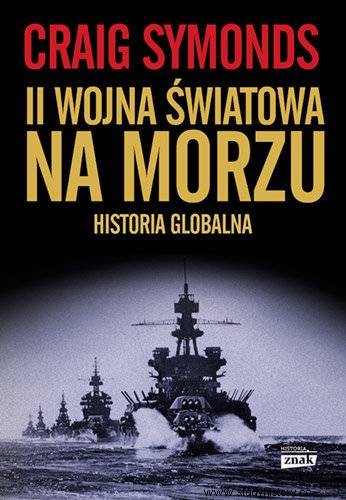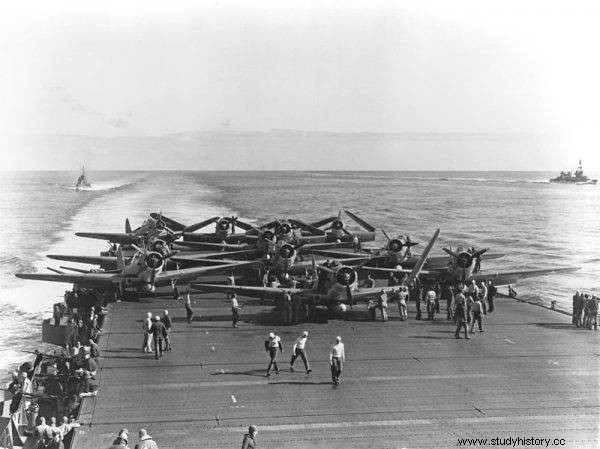One slightly damaged Japanese carrier was left at the shipyard and missed during the great naval engagement known today as the Battle of Midway. The Japanese lost this battle, which allowed the Americans to go on the offensive and defeat Japan in 1945. One accurately dropped torpedo immobilized the rudder of the battleship "Bismarck", which brought her doom. After it sank, the Allies gained an advantage in the Atlantic. There is no doubt:wars are won or lost at sea.
This is the thesis put forward by Craig Symonds, an outstanding American naval historian, whose book "The Second World War at Sea:Global History" was published in Poland a few days ago. Symonds certainly knows what he writes about, because he himself served in the U.S. Navy and worked at several naval military academies.
In his latest work he efficiently transports us from sea to sea and from ocean to ocean, pointing out the key moments of the war at sea, which decided about the severe defeats of the Allies in the first phase, and then, after taking the initiative, to defeat the Axis countries, i.e. Germany, Italy and Japan.
Usually, during any armed conflict, public attention is focused on activities on land:defending and seizing cities, the course of the front line, capturing bridges and crossings, controlling the area, taking over strategic objects:airports, power plants, refineries.
Meanwhile, no less important (and maybe even more important) action always takes place at sea, where the front line does not exist, and one ship and one captain can decide ... everything . This was also the case during World War II, when the sinking or damage of one ship allowed them to gain an advantage and go on the offensive on the entire "front". This was the case with the famous battleship "Bismarck" and its rally to the Atlantic.
Fairy Tales and Facts
When on May 24, 1941, Bismarck sank HMS Hood, the largest English ship at the time, in six volleys from a distance of 18 km, and awakened at 7 am, Churchill was shocked and furious. After smoking a few cigars and "eating" his breakfast in the form of a glass of whiskey, he ordered that all available forces be thrown into the search for "Bismarck" hiding in the squalls in the Atlantic. Churchill also demanded bolder actions from the commanders of the ships, who had been simply afraid of a fight with a mighty battleship and were fleeing (leaving) the battlefield.
The Prime Minister got what he demanded from his admirals, although in this case the victory was not determined by large, heavily armed surface ships, but ... a tiny Swordfish plane taking off from an aircraft carrier. This biplane torpedo-bomber, rather reminiscent of WW1 machines, installed two accurate torpedoes in the fuselage.

You can read more about this in the book “World War II at Sea. Global History ”by Craig Symonds. The book was published by Znak Publishing House.
One of them hit the stern and blocked the rudder of the vessel, which resulted in the loss of steering and plunged the "Bismarck" under the barrels and torpedo tubes of British ships. Craig Symonds describes the fight as follows:
"Rodney" dropped first blood - at 9.02 a 406mm missile hit the Bismarck's bow superstructure. Both forward towers of the battleship were immobilized - the guns of the first fell sadly to the sea, while the second was aimed uselessly at the sky . No orders came from the bridge anymore, certainly because both Lütjens and Lindemann were killed.
Craig Symonds is not deciding whether the operation of the Polish destroyer ORP Piorun contributed to the sinking of the "Bismarck". What's more, he doesn't even mention "Piorun" in the description of the battle with the German battleship! So it seems that we can put another Polish myth on the shelf. In this case, it could be one with the words "sea fairy tales".
The battle that changed the fate of war
On the following pages of the book, which has almost 900 pages (!), Symonds vividly describes other key battles on the world's seas and oceans, paying attention not only to the "circumstances of nature", i.e. the natural factors enabling victory (rain, fog, night), but also the personality and mental resistance of admirals, vice admirals, fleet and squadron commanders. These issues were of great importance in the clashes in which neither side had a visible quantitative or technical advantage. The American historian repeatedly notes that in the case of maritime operations, great importance for victory or defeat was ... coincidence.
For example, to attack the island of Midway, the Japanese sent a powerful fleet supported by four aircraft carriers. Originally there were supposed to be five, but one - "Zuikaku" - stayed in port because it lost some of its planes in the Battle of the Coral Sea. “The Japanese could have done like the Americans who moved planes and pilots from Saratoga to Yorktown and replenish the air force of the Zuikaku, but that was against Japanese sense of order. As a result, the Japanese only sent four aircraft carriers to Midway, ”writes Symonds.

Torpedo aircraft TBD-1 of the VT-6 squadron on board the USS "Enterprise"
The lack of a fifth "floating airport" determined the outcome of the battle. The Americans had three operational carriers in this Pacific area, and the Midway airport was the fourth. "The Atoll could not maneuver, but it also could not be sunk" Notes Craig Symonds soberly.
The Battle of Midway marked a turning point in the Pacific War and allowed the Americans to move on to offensive operations, incl. enabled the landing of Guadalcanal and subsequent landings of marines on larger and smaller islands occupied by the Japanese. Sea battles, in which the American and Japanese fleets clashed in the years that followed, always ended in the same way - with the victory of the Americans. This is because at that time they had a huge air advantage, guaranteed by an unlimited number of aircraft taking off from aircraft carriers.
Meanwhile, the Japanese did not have any aircraft carriers anymore, and their super-threatening, super-powerful, super-resistant and, in addition, the world's largest super-battleships "Musashi" and "Yamato", were sunk by American pilots in several / tens of minutes.
It was aviation, and more specifically aircraft taking off from carriers, that decided the outcome of World War II at sea . And not only in the great battles in the Atlantic and Pacific, but also in the smaller Anglo-Italian clashes in the Mediterranean and Anglo-German clashes in the North and Norwegian Seas. So it seems that the thesis that "wars are won at sea" should be supplemented with "and over it".
